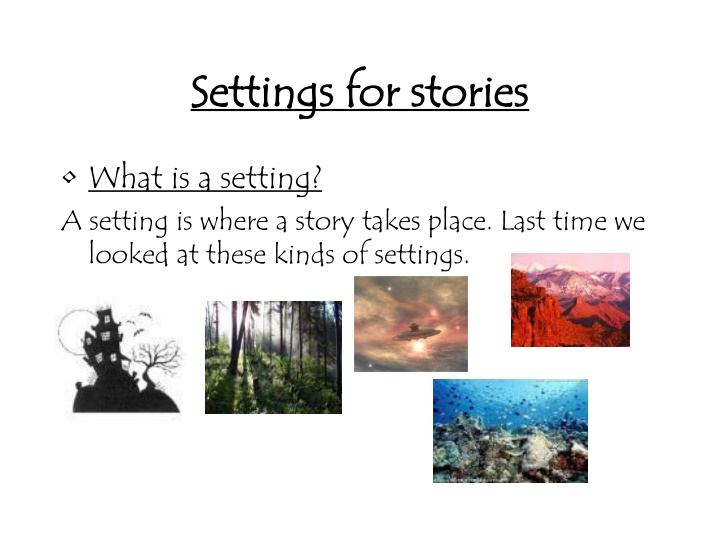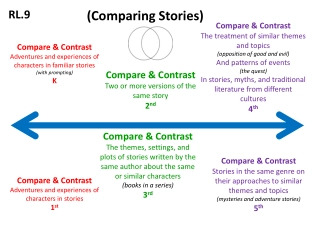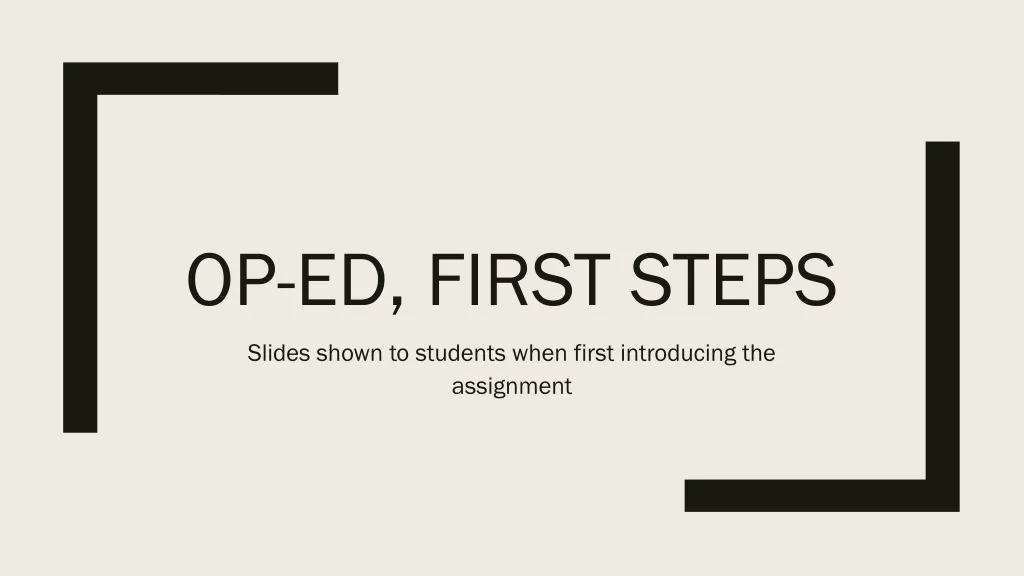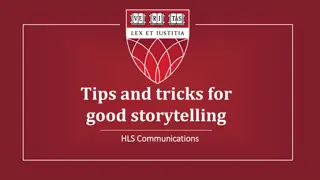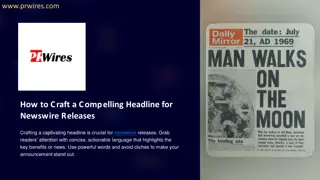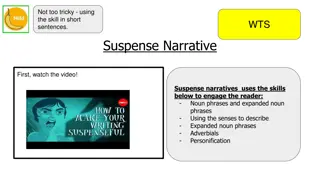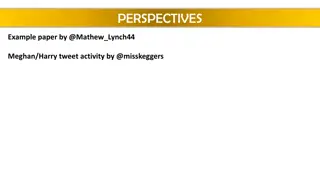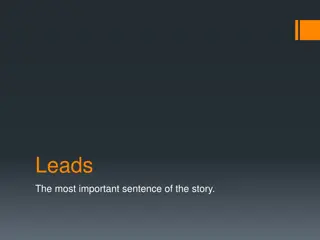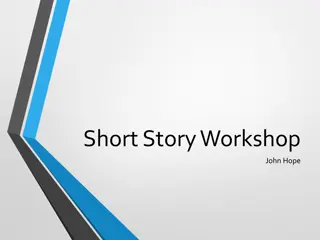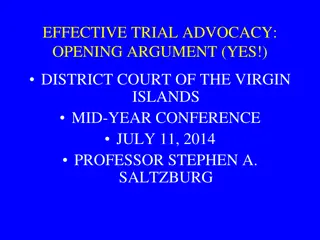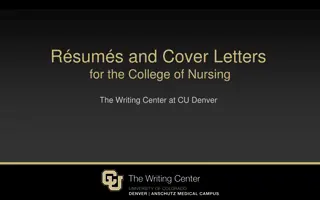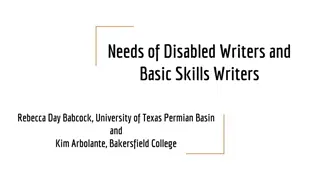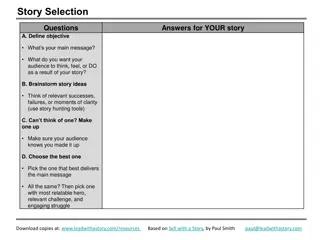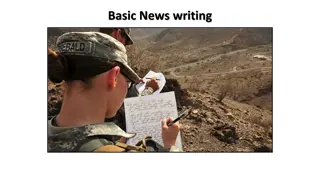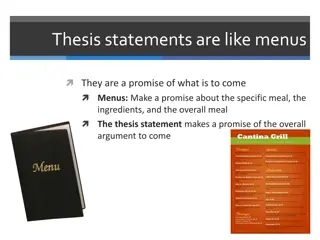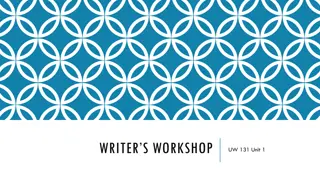Crafting Compelling Stories: Tips and Techniques for Writers
Explore tips on creating captivating settings, developing realistic characters, starting a story effectively, using descriptive writing techniques, and enhancing your stories with literary devices like alliteration, rhyme, and similes. Enhance your storytelling skills with practical advice and examples.
Uploaded on Sep 06, 2024 | 1 Views
Download Presentation

Please find below an Image/Link to download the presentation.
The content on the website is provided AS IS for your information and personal use only. It may not be sold, licensed, or shared on other websites without obtaining consent from the author.If you encounter any issues during the download, it is possible that the publisher has removed the file from their server.
You are allowed to download the files provided on this website for personal or commercial use, subject to the condition that they are used lawfully. All files are the property of their respective owners.
The content on the website is provided AS IS for your information and personal use only. It may not be sold, licensed, or shared on other websites without obtaining consent from the author.
E N D
Presentation Transcript
Settings for stories Settings for stories What is a setting? A setting is where a story takes place. Last time we looked at these kinds of settings.
Characters Characters Two or three characters are usually enough for a short story. Here's how to make the characters sound real: Try to show how they feel using adjectives and adverbs, for example: tired, excitedly, grateful, angrily, happy, sadly, curious, worriedly, relieved, nervously Give them suitable names. For example: Pirates: Captain Peg-Leg, Scar-faced Bill, Sly Sam, One-eyed Pete Astronauts: Commander Ben Lewis, Assistant Commander Buzz Owens, Captain Tilly Jones Don't just use your friend's names in a story! Describe what they look like and how they move. For example: A wizened old man shuffling about the house in slippers. A giant, hairy, orange caterpillar creeping slowly along. A ten year old girl, rather small for her age, skipped merrily along the street, her long fair hair flying in the wind.
How do I start a good story? There are three different ways to start a story: Dialogue: "Sharks!" shouted the ship's look out, "hundreds of them!" "They seem to be heading our way," cried the Captain. Action: An ear splitting whistle made all the pirates leap to attention. At once they ran in different directions, bumping into one another, scrambling over untidy piles of ropes and tarpaulin, sliding down rickety ladders, all trying to be the first in the queue for lunch. Description: The sea glistened like a sparkling, silver mirror. Waves lapped gently at the sides of the Saucy Sue as she sailed silently along in the cool, refreshing breeze, her Jolly Roger flag fluttering limply. Seagulls circled overhead, calling to each other. No-one would guess what terrible adventure lay ahead for Captain Peg-Leg and his crew of daring pirates.
Writing a good story These question words are important when writing stories. who, what, how, where, when, and why The tiny birdhopped quickly across the garden, picked up the bread, and immediately flew offto a safe placeto eat it. Now you try with these pictures:
Use these ways to improve your writing! Alliteration (words starting with the same letter) - e.g. dark, dank, dreary forest; crowded, cobbled streets Rhyme - e.g. hustle and bustle; a rumbling and a tumbling Patterning - e.g. in the highest branches of the furthest tree; travelling faster and faster Onomatopoeia (words that sound like the thing they describe)- e.g. jingling, jangling, tinkling coins. Similes compare one thing to another and are introduced by the words 'like' or 'as', e.g. The wet mud was sticky like fudge cake. Metaphors compare one thing with another, but are not introduced by 'like' or 'as', e.g. The wet mud was sticky fudge cake. Similes : The moon hung in the sky like it was on an invisible thread. The storm was as violent as a ranting bull. The wind was like a roaring lion shaking its mane. To change the similes to metaphors, take out the words as and like: The moon hung in the sky on an invisible thread. The storm was a ranting bull. The wind was a roaring lion shaking its mane.
What should I include in a good story? Events An interesting story will contain several events. A strong exciting plot has an unexpected event, a crisis, or a problem, which needs to be sorted out by the end of a story. Stories can contain more than one problem. Plans could go wrong: There could be an accident. Someone or something could get lost. A machine could break down. Something important could get stolen.
Story endings Explain the result of the events or show how the problem was solved. (But don't end with everyone going home for tea or someone waking up to find it was all a dream - that's boring!) Endings usually bring the story round 'full circle'. For example, Start: Three scruffy pirates sat gloomily around a table in the Lord Nelson pub, staring down in to their empty beer glasses. One by one they emptied out their pockets. It seemed they had all run out of money. Ending: The pirate gang made their way down the quay to their favourite pub to celebrate their success. They had earned enough money now to buy a year's worth of beer - and have change.
Story endings The final sentence is as important as the opening sentence. It usually sums up the story's theme or message. It had been the best day of my life. I'll never forget her. If only he hadn't been so selfish. She realised taking part is much more important than winning. It just goes to show, crime really doesn't pay. They were richer than they could ever have dreamed.
Storyboards What are storyboards? Story boards help you to plan a story without writing it all out. Opening? Setting? Characters? Problem . How it is solved Ending .
Now you are going to plan a great story. Checklist: Title- think of a great title for your story. Setting- where will the story take place? Characters- who will be in the story? What problem will they have? How will they solve the problem? How will the story end?
